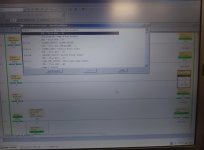Mister Mac
Member
Hi Everyone,
I am supporting a system which runs on a SLC 500 (1747-L532). A fault has developed whereby the output state of some digital outputs do not change within the ladder logic. Basically, on a rung, an XIO controls an OTE. When the XIO is high the OTE should be also high, however the OTE is not changing state. The OTE is only used on this 1 rung within the program and the routine is being scanned. I have trended the XIO bit to confirm no oscillation and at a trend refresh rate I cannot see any change of state. The XIO is controlled via a compare instruction which is stable.
I have plugged out the comms to the machine HMI to confirm nothing is being written from the HMI that may be causing the issue. I have also tried another processor from spares but issue remains.
Is there something very simple I could be missing here?
All suggestions appreciated.




I am supporting a system which runs on a SLC 500 (1747-L532). A fault has developed whereby the output state of some digital outputs do not change within the ladder logic. Basically, on a rung, an XIO controls an OTE. When the XIO is high the OTE should be also high, however the OTE is not changing state. The OTE is only used on this 1 rung within the program and the routine is being scanned. I have trended the XIO bit to confirm no oscillation and at a trend refresh rate I cannot see any change of state. The XIO is controlled via a compare instruction which is stable.
I have plugged out the comms to the machine HMI to confirm nothing is being written from the HMI that may be causing the issue. I have also tried another processor from spares but issue remains.
Is there something very simple I could be missing here?
All suggestions appreciated.










